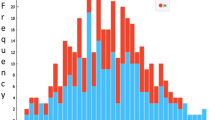Abstract
In the world of modern medicine, though there is lot of medical achievements, some diseases still continue to pest the human race. Unfortunately, dementia is one such disease. All over the world, a large number of people are suffering from dementia. Dementia is a brain-related disease. Diagnosis of the disease at the earlier stage is the requirement of the day. Alzheimer's disease (AD) is one of the types of the dementia, and around 60 % of demented are affected from Alzheimer’s disease (Salmon and Bondi in Neuro psychological assessment of dementia. National Institutes of Health, 2010). All over the world, there are around 35 million people suffering from AD and this number is expected to double by 2030 and more than triple by 2050, that is to 115 million (Prince et al. in World Alzheimer report 2013: journey of caringan analysis of long-term care for dementia. Kings College, London, 2013). Diagnosis of this disease at an early stage will help the patients to lead a quality life for the remaining tenure of their life. In this paper, the authors have collected data of 466 subjects by conducting neuropsychological tests. The authors focus on diagnosis of AD for neuropsychological tests using Naive Bayes.







Similar content being viewed by others
References
http://www.capitalfm.co.ke/lifestyle/2013/12/06/44-million-now-suffer-from-dementia-worldwide
Viswanathan A, Rocca WA, Tzourio C (2009) Vascular risk factors and dementia: how to move forward? Neurology 72:368–374
Luck T et al (2010) Incidence of mild cognitive impairment: a systematic review. J Dement Geriatr Cogn Disord 29:P164175
Thies W, Bleiler L (2013) Alzheimer’s facts and figures, Alzheimer's dement. J Alzheimer’s Assoc
http://alzheimers.emedtv.com/dementia/dementia-risk-factors.html
Bhagya Shree SR, Sheshadri HS, Joshi S (2014) A review on the method of diagnosing Alzheimer’s disease using data mining. Int J Eng Res Technol 3(3):2417–2420 (ISSN: 2278-0181)
Bhagyashree SR, Sheshadri HS (2014) An approach in the diagnosis of Alzheimer disease—a survey. Int J Eng Trends Technol (IJETT) 7(1):41–43 (ISSN: 2231-5381)
Sosa AL et al (2009) Population normative data for the 10/66 Dementia Research Group cognitive test battery from Latin America, India and China: across-sectional survey. BMC Neurol 9:1–11
Han J, Kamber M, Pei J (2012) Data mining: concepts and techniques, 3rd edn. Elsevier, Amsterdam
Soman KP et al (2012) Insight into data mining theory and concepts, 6th edn. PHI Learning Pvt. Ltd, New Delhi
Carnero-Pardo C, Espejo-Martnez B, Lopez-Alcalde S, Espinosa-Garca M, Saez-Zea C, Hernandez-Torres E, Navarro-Espigares JL, Vlchez-Carrillo R (2011) Diagnostic accuracy, effectiveness and cost for cognitive impairment and dementia screening of three short cognitive tests applicable to illiterates. PLoS One 6(11):1–6
Williams JA, Weakley A, Cook DJ, Schmitter-Edgecombe M (2013) Machine learning techniques for diagnostic differentiation of mild cognitive impairment and dementia. In: Workshops at the association for the advancement of artificial intelligence conference in expanding the boundaries of health informatics using artificial intelligence, pp 71–76
Schmitter-Edgecombe M, Parsey C, Cook DJ (2011) Cognitive correlates of functional performance in older adults: comparison of self report, direct observation and performance based measures. J Int Neuropsychol Soc 17:853–864
Schmitter-Edgecombe M et al (2009) Characterizing multiple memory deficits and their relation to everyday functioning in individuals with mild cognitive impairment. Neuropsychology 23:168–177
Shankle WR, Datta P, Dillencourt M, Pazzani M (1996) Improving dementia screening tests with machine learning. Alzheimer’s Res 2(714):95–99
Datta P, Shankle WR, Pazzani M (1996) Applying machine learning to an Alzheimer’s database. In: Conference proceedings of the AAAI symposium
Joshi S, Shenoy PD, Venugopal KR, Patnaik LM (2010) Classification of neuro degenerative disorders based on major risk factors employing machine learning techniques. IACSIT Int J Eng Technol 2(4):350–355 (ISSN:1793-8236)
Joshi S, Shenoy PD, Venugopal KR, Patnaik LM (2009) Evaluation of different stages of dementia employing neuropsychological and machine learning techniques. In: First international conference on advanced computing, pp 154–160
Mani S, Dick MB, Pazzani MJ, Teng EL, Kempler D, Taussig IM (1999) Refinement of neuro-psychological tests for dementia screening in a cross cultural population using machine learning. Artif Intell Med 1620:326–335
Bin Othman MF, Yau TMS (2007) Comparison of different classification techniques using WEKA for breast cancer. In: 3rd Kuala Lumpur international conference on biomedical engineering 2006. Springer, Berlin, Heidelberg, pp 520–523
Singhal S, Jena M (2013) A study on WEKA tool for data preprocessing, classification and clustering. Int J Innov Technol Explor Eng (IJITEE) 2(6):250–253
Andreeva P, Dimitrova M, Radeva P (2004) Data mining learning models and algorithms for medical applications. In: Proceedings of the 18th conference on Saer, pp 11–18
Witten IH, Frank E (2005) Data mining: practical machine learning tools and techniques, 2nd edn. Morgan Kaufmann Publishers
Acknowledgments
The authors are thankful to Dr. Murali Krishna, Earlier Scientist Research Fellow, Wellcome DBT Allianz, CSI Holdsworth Memorial Mission Hospital, Mysore, Dr. L. Basavaraj, Principal, ATME, Mysore and to the research colleagues who supported with the data in respect of the Alzheimer’s disease.
Author information
Authors and Affiliations
Corresponding author
Rights and permissions
About this article
Cite this article
Bhagya Shree, S.R., Sheshadri, H.S. Diagnosis of Alzheimer's disease using Naive Bayesian Classifier. Neural Comput & Applic 29, 123–132 (2018). https://doi.org/10.1007/s00521-016-2416-3
Received:
Accepted:
Published:
Issue Date:
DOI: https://doi.org/10.1007/s00521-016-2416-3




